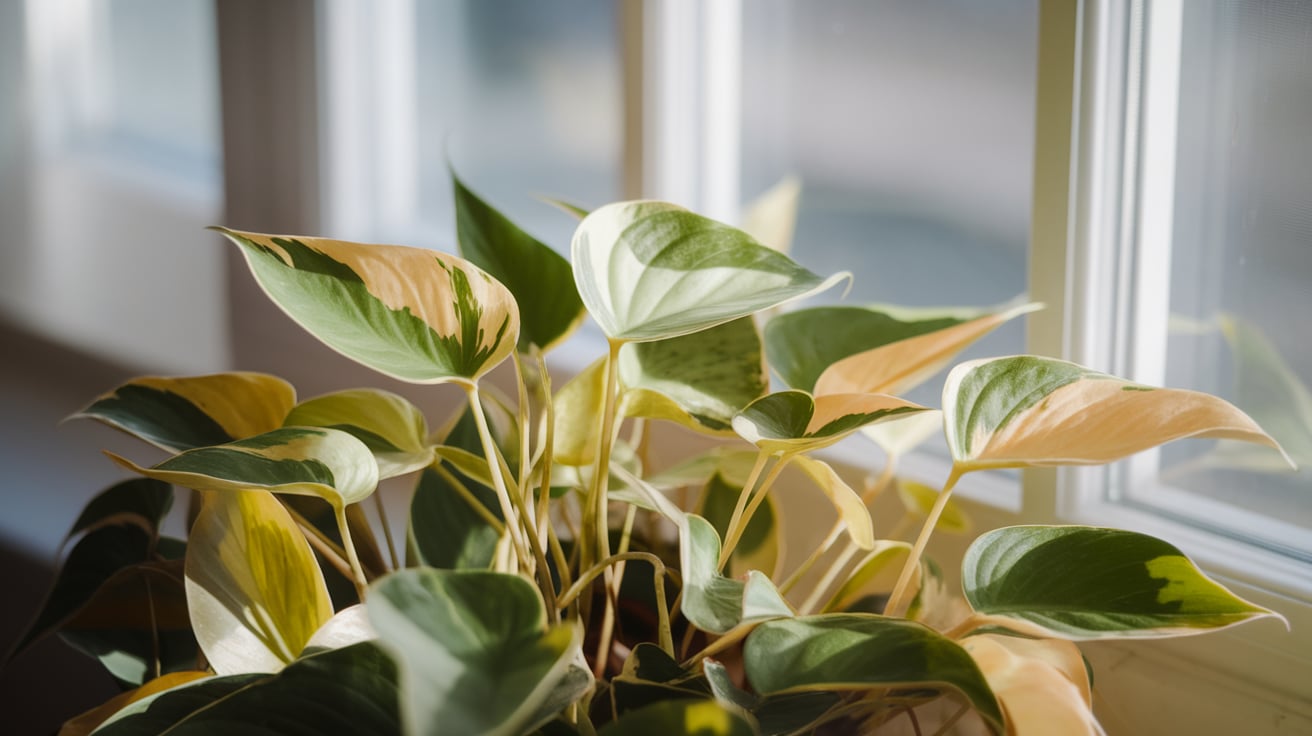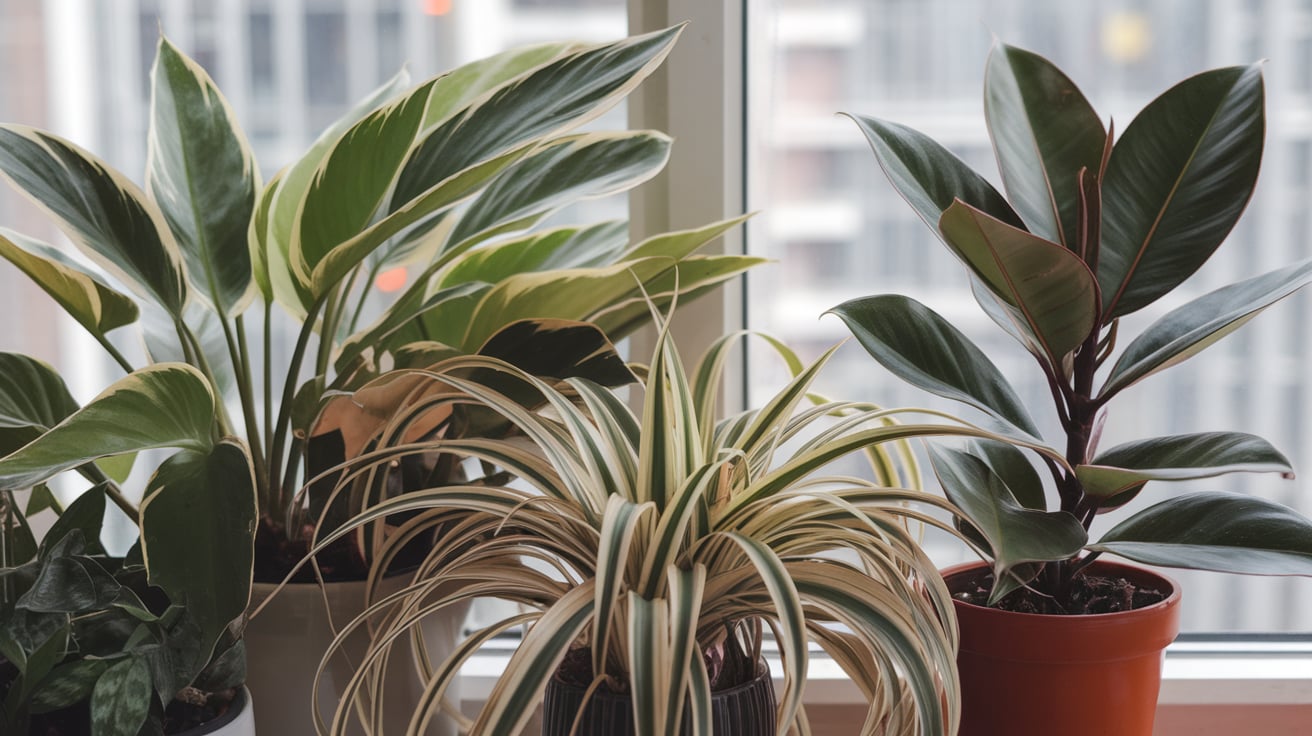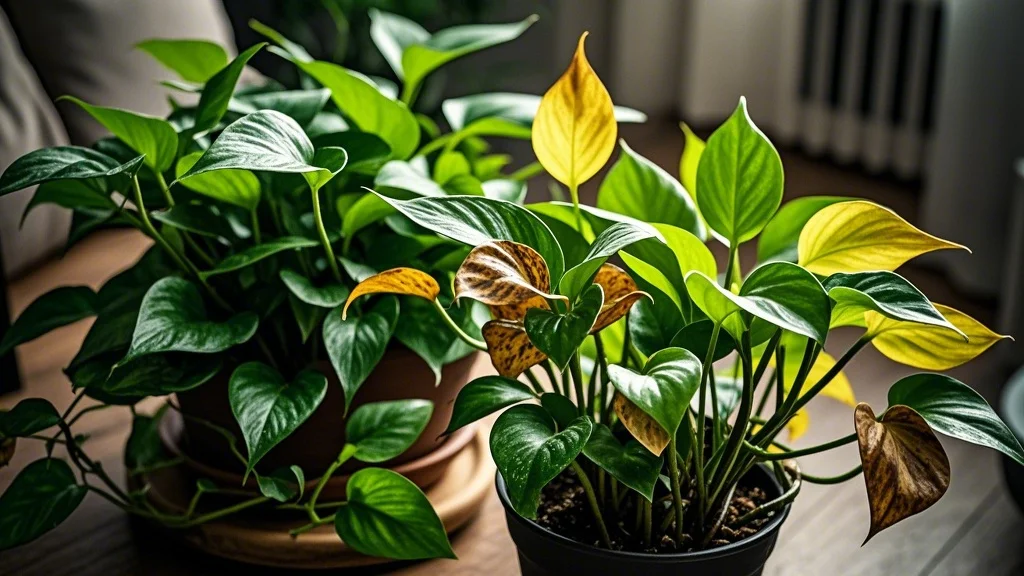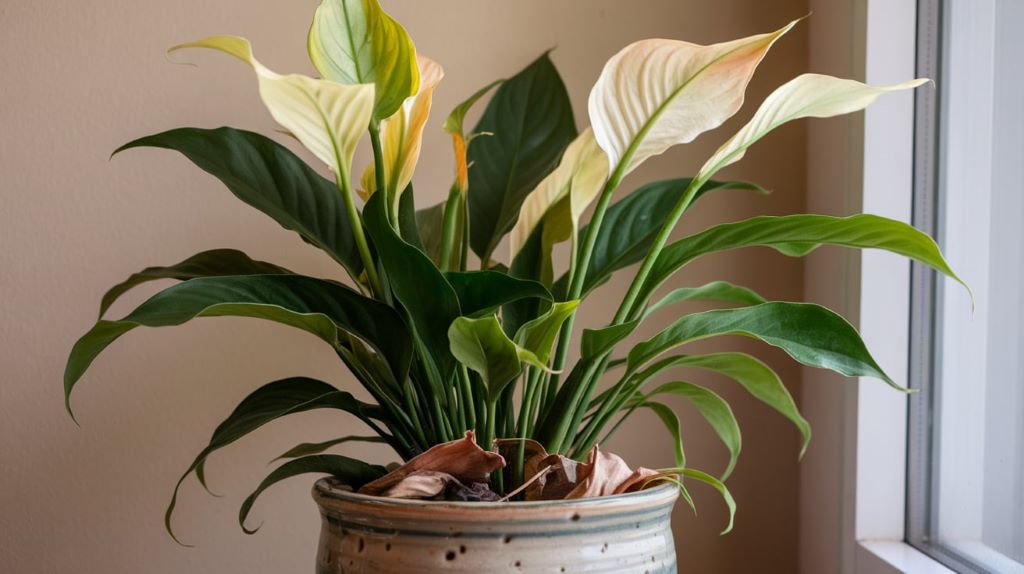Contents
- 1 Understanding the Natural Cycle of Plant Colors
- 2 Why Plants Change Color With the Seasons
- 3 Normal Seasonal Color Changes by Season
- 4 Distinguishing Normal Yellowing from Problems
- 5 Plant-Specific Seasonal Color Changes
- 6 Supporting Plants Through Seasonal Transitions
- 7 The Light Connection: The Primary Driver of Seasonal Changes
- 8 Common Questions About Seasonal Yellowing
- 8.1 Is it normal for my plant to drop several yellow leaves in fall?
- 8.2 Should I increase fertilizer when I notice seasonal yellowing?
- 8.3 Will grow lights prevent seasonal yellowing?
- 8.4 Why do my plants yellow more in my north-facing apartment?
- 8.5 Should I move yellowing plants closer to windows in winter?
- 9 Tracking Seasonal Changes: A Valuable Practice
- 10 Conclusion: Embracing the Natural Rhythm
Understanding the Natural Cycle of Plant Colors
Indoor plants, despite living in our climate-controlled homes, remain deeply connected to natural cycles. One of the most common concerns among urban gardeners is yellowing leaves, which often trigger alarm bells about plant health. However, not all yellowing indicates a problem—many color changes are simply part of your plant’s natural seasonal response.
For city dwellers with limited outdoor space, understanding these normal fluctuations can save unnecessary worry and prevent overcompensation with water or fertilizer that might actually harm your plants.
Why Plants Change Color With the Seasons

Even indoors, plants respond to subtle seasonal cues:
Light Changes
The most significant seasonal factor affecting indoor plants is light variation. As days shorten in fall and winter, the reduced light intensity and duration trigger physiological changes in plants:
- Photosynthesis reduction: With less light available, plants produce less chlorophyll
- Energy conservation: Many plants shed older leaves to focus resources on maintaining newer growth
- Growth slowdown: Most houseplants enter a semi-dormant state requiring less energy
A north-facing apartment in Minneapolis will experience dramatically different light levels between June and December—your plants notice this difference even if your thermostat remains constant.
Temperature Fluctuations
Even with central heating, indoor temperatures fluctuate:
- Window proximity: Plants near windows experience temperature drops at night, especially in winter
- Drafts: Seasonal heating systems create new air currents that affect plants
- Humidity changes: Winter heating typically reduces indoor humidity by 10-20%
These subtle changes signal seasonal shifts to your plants, often triggering yellowing as part of their adaptation strategy.
Plant Biological Clocks
Many houseplants maintain internal rhythms synchronized with natural seasons:
- Some tropical plants have evolved to shed older leaves during dry seasons
- Certain species prepare for dormancy periods regardless of stable indoor conditions
- Plants with distinct growing seasons may naturally yellow before rest periods
Normal Seasonal Color Changes by Season
Fall Yellowing (September-November)
As daylight hours decrease, expect these normal changes:
- Outer/lower leaf yellowing: Plants often sacrifice older leaves first
- Slowed growth: New leaves emerge more slowly and may be smaller
- Variegated plants: May lose some variegation in response to lower light
Common plants with noticeable fall changes:
-
- Pothos (Epipremnum aureum)
- Spider plants (Chlorophytum comosum)
- Peace lilies (Spathiphyllum)
“My golden pothos always drops a few yellow leaves in October. Rather than panicking, I’ve learned this is just its way of adapting to the changing light in my apartment.” — Maria, Chicago apartment gardener
Winter Adjustments (December-February)
Winter presents the most challenging season for indoor plants:
- Generalized yellowing: Overall lighter green appearance in many plants
- Leaf drop: More pronounced shedding of older growth
- Dormancy: Some species may yellow significantly before entering rest periods
Plants commonly showing winter yellowing:
- Chinese evergreen (Aglaonema)
- Dracaena varieties
- Rubber plants (Ficus elastica)
During winter, it’s normal for plants to maintain their size rather than produce significant new growth. This conservation strategy helps them survive until light conditions improve.
Spring Transition (March-May)
As daylight increases, plants undergo renewal:
- Old leaf shedding: Plants often discard winter-stressed leaves as energy returns
- Temporary yellowing: New growth may trigger yellowing of older leaves as resources shift
- Color intensification: Existing leaves gradually deepen in color with increasing light
Plants with noticeable spring transitions:
- Philodendrons
- Monstera deliciosa
- Ferns
Summer Stability (June-August)
Summer typically provides optimal growing conditions:
- Color consistency: Most plants maintain stable coloration
- Rapid growth: Resources directed to new growth rather than maintaining old leaves
- Light stress: Occasionally, direct summer sun can cause yellowing from light intensity
Plants that may show summer yellowing:
- Plants in direct south/west windows
- Light-sensitive species like calatheas and marantas
Distinguishing Normal Yellowing from Problems
While seasonal yellowing is natural, certain patterns indicate potential issues:
Normal Seasonal Yellowing:
- Affects older, lower leaves first
- Progresses slowly (over weeks)
- Appears on multiple plants simultaneously
- Follows seasonal light changes
- Yellowing is uniform across the leaf
Problematic Yellowing:
- Affects new growth or appears randomly throughout plant
- Develops rapidly (days)
- Shows additional symptoms (brown spots, curling, etc.)
- Accompanied by soil issues (extremely dry or soggy)
- Pattern appears mottled or spotty
Plant-Specific Seasonal Color Changes
Different plant families display characteristic seasonal responses:
Aroids (Philodendron, Monstera, Pothos)
These popular houseplants typically show:
- Gradual yellowing of 1-3 oldest leaves during fall transition
- Slowed growth and lighter green color during winter
- Rapid spring recovery with minimal yellowing
Dracaena Family
These structural plants often display:
- Tip yellowing in response to humidity changes
- Lower leaf yellowing during light reductions
- Slow but steady recovery when conditions improve
Ferns
These ancient plants have distinct seasonal patterns:
- Significant frond yellowing during fall transition
- Reduced size of winter fronds
- Complete renewal of many fronds in spring
Succulents and Cacti
Desert-adapted plants show subtle changes:
- Color intensification (reds/purples) during winter light reduction
- Etiolation (stretching) rather than yellowing in low light
- Sunburn yellowing possible during sudden summer light increases
Supporting Plants Through Seasonal Transitions
While seasonal changes are normal, you can help ease these transitions:
Fall Preparation (August-September)
- Gradually reduce fertilizing frequency
- Clean leaves to maximize light absorption
- Consider supplemental lighting for plants requiring high light
- Move plants closer to windows as light decreases
Winter Care (December-February)
- Reduce watering frequency (soil dries more slowly)
- Maintain distance from heating vents
- Consider humidity solutions (grouping plants, humidifiers)
- Accept some yellowing as normal adaptation
Spring Transition (March-May)
- Gradually increase watering as growth resumes
- Begin light fertilization as new growth appears
- Remove winter-damaged leaves
- Rotate plants to ensure even light exposure
Summer Adjustments (June-August)
- Monitor for direct sun exposure (which can intensify through windows)
- Increase watering frequency as needed
- Provide good air circulation during peak growth periods
The Light Connection: The Primary Driver of Seasonal Changes
The relationship between light and leaf color is fundamental:
The Science of Seasonal Light Changes
Even in urban environments, seasonal light varies dramatically:
- Winter light reduction: Northern hemisphere cities experience 30-50% less light intensity in winter
- Light duration: Shorter days mean fewer photosynthesis hours
- Light quality: Winter sunlight contains different spectral compositions
- Light angle: Lower winter sun creates deeper shadows in urban environments
How Plants Measure Seasonal Light
Plants use sophisticated mechanisms to detect seasonal changes:
- Phytochromes: Light-sensitive proteins that detect day length
- Cryptochromes: Blue light receptors that measure light intensity
- Photoreceptors: Specialized cells that trigger hormonal responses
These systems evolved over millions of years to help plants synchronize with natural cycles—explaining why even indoor plants respond to seasonal shifts.
Common Questions About Seasonal Yellowing
Is it normal for my plant to drop several yellow leaves in fall?
Yes, particularly for vining plants like pothos and philodendrons. As light decreases, plants often shed older leaves to conserve energy. This is especially common in plants that grew vigorously during summer months.
Should I increase fertilizer when I notice seasonal yellowing?
Generally no. Seasonal yellowing is typically a light response, not a nutrient deficiency. In fact, fertilizing during fall and winter can stress plants during their natural slowdown period. Resume regular fertilizing when active growth returns in spring.
Will grow lights prevent seasonal yellowing?
Supplemental lighting can reduce seasonal yellowing by maintaining more consistent light levels. However, some plants benefit from natural rest periods, so mimicking some seasonal change can be healthy. Consider using grow lights to extend daylight hours rather than creating artificial summer-like conditions year-round.
Why do my plants yellow more in my north-facing apartment?
North-facing windows receive the least direct sunlight year-round, making seasonal light fluctuations more pronounced. Plants in these locations experience more dramatic light reduction in winter, often resulting in more noticeable yellowing compared to south-facing exposures.
Should I move yellowing plants closer to windows in winter?
Yes, this is generally helpful. Moving plants closer to light sources during winter months can help them maintain better color. Just be mindful of cold drafts near windows, which can cause additional stress.
Tracking Seasonal Changes: A Valuable Practice
Keeping simple records of your plants’ seasonal changes offers several benefits:
- Helps distinguish between normal patterns and potential problems
- Creates awareness of your home’s specific light conditions
- Builds confidence in recognizing healthy plant rhythms
- Provides early warning of unusual changes
A basic plant journal noting monthly observations and any care adjustments can transform seasonal yellowing from a worry to a fascinating aspect of indoor gardening.

Conclusion: Embracing the Natural Rhythm
Seasonal yellowing represents your houseplants’ connection to natural cycles—a reminder that even in our climate-controlled urban environments, plants remain attuned to the world outside our windows. By understanding these normal transitions, you can:
- Reduce unnecessary interventions that might harm plants
- Appreciate the subtle seasonal changes in your indoor garden
- Develop a deeper understanding of each plant’s unique needs
- Distinguish more easily between normal changes and genuine problems
The next time you notice yellowing leaves as seasons change, observe the pattern before reaching for solutions. Often, the best approach is simply to adjust your expectations and appreciate your plants’ remarkable ability to adapt to our shared environment.
For urban gardeners, this awareness creates a meaningful connection to natural cycles that might otherwise go unnoticed in city living—a reminder that even in the most metropolitan settings, we remain part of the natural world and its rhythmic changes.
Looking for more seasonal plant care advice? Explore our guides on winter humidity solutions, grow light options for dark months, and spring care routines at OwnGardens.com.








